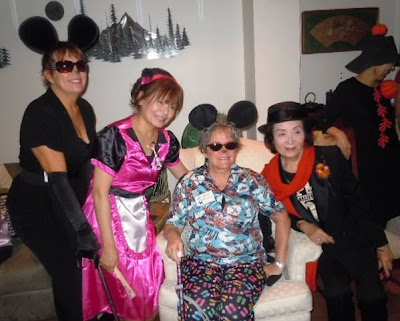The good news is that the one of us working on a novel has received a nibble from an agent who might be interested in the book he wrote during National Novel Writing Month last year, a military thriller-romance set on the USS Blue Ridge. (So far I've only made it through the first sixteen chapters. His constant refrain these days is "It's fiction!" especially when I start wondering where he came up with all these ideas about romance aboard a Navy flagship.)
The bad news is that two weeks' worth of photographs and memories have been placed on the back burner. I haven't finished sharing the highpoints of the trip to Kanazawa and I haven't even started to tell you about our trip to Nikko or the flower exhibition in Tokyo or the Yokohama Quilt Festival. We've already made gingerbread houses and frosted Christmas cookies with the Japanese military spouses and we've made plans to spend the Thanksgiving weekend in Hakone and Tokyo. Assuming I can tear myself away from Bejeweled Blitz for four days . . .
What should I write about today? Since visiting the workshop of the last remaining traditional umbrella maker in Kanazawa was one of the highpoints of that trip for me, I'd like to unfurl a few for you.
A wagasa is a Japanese traditional umbrella consisting of washi (Japanese paper) with a bamboo handle and ribs. If you have ever sipped a mai tai or similar frothy alcoholic beverage, you are familiar with the miniature versions of these umbrellas. Nowadays the Japanese favor our much less expensive Western-style unbrellas for daily use, but wagasa are still used for traditional Japanese tea ceremonies and dance.
Because it rains and snows a lot in Kanazawa, their wagasa is famously strong. Four layers of Japanese paper are painstakingly pasted to the central part of the umbrella. Another characteristic of Kanazawa wagasa is its splendid color.
Hiroshi Matsuda has been making wagasa for 75 years. He started working in his father's umbrella shop when he was twelve years old. Yes, he is as happy and adorable in person as he looks in the picture above. If you want to know a little more about Matsuda-sama, click here.
Many of his umbrellas feature real leaves, clover and such, pasted between the layers of washi paper (see left).
Simply glimpsing Matsuda hard at work would have been enough of a treat, but Fearless and I also had the pleasure of watching Matsuzaki-san talk Matsuda-sama into selling her an umbrella. They engaged in some serious flirting and she took pouting to a new level before waltzing out of the shop with a purple number that set her back a mere 35,000 yen (roughly $400).
Fearless and I were invited to select smaller souvenir-size umbrellas, about eight inches high, while Matsuda-sama wrapped the purple umbrella.
 |
| Peevish performs "The Flower Drum Song" |

















































